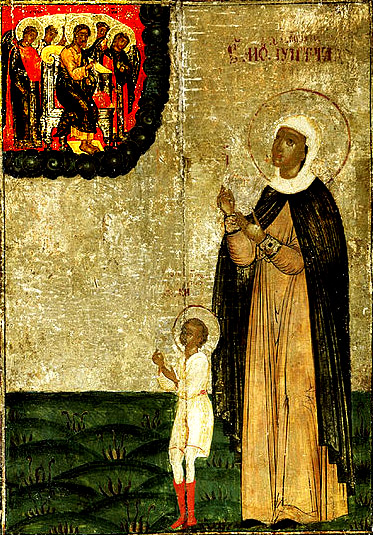The Legend puts these deaths in 230 A.D, but Butler prefers 304. Later in the 4th century the boy martyr's reputed relics were taken to France, where his popularity grew under the name of St. Cyr.1
According to both Farmer and Duchet-Suchaux, the boar is sometimes an attribute of Cyricus because Charlemagne once dreamt that the saint had saved him from one.2 I have not yet seen any images of Cyricus with a boar, nor is the boar story in the Golden Legend or any of the narratives collected in the Acta Sanctorum.
In some pictures Julitta stands beside her son and gestures toward a vision of Christ in Heaven, as in the first picture at right. This refers to a passage in one of the passion narratives: After her son has declared his Christian faith she asks God to grant him the crown of martyrdom. Then a voice from Heaven declares, "Hear, o daughter, your great son will be in eternal glory."3
Other portraits simply place the son beside the mother and leave out the heavenly vision. In the 12th-century Catalan Frontal de Durro Julitta stands frontally with Cyricus in her arms, in the manner of Madonna and Child images (Camps y Montserrat, 93).
ST. CYRIACUS OF ROME
The bathing tub in the sculpture at right may be due to a confusion between the boy and St. Cyriacus, an adult martyr memorialized in the Depositio Martyrum in 354. A later legend puts his death during the persecutions of Maximian and Diocletian in 304 and says Cyriacus had ministered to the slaves in the Baths of Diocletian and performed exorcisms on the daughters of the Emperor and the King of Persia.4 One medieval breviary lesson says that he was beaten to death with cudgels, and this is pictured in one of the panels of the "Martyrs' Window" in Freiburg Cathedral.5 From the 5th century until the 15th there was a church in Rome dedicated to him and known as S. Cyriacus in Thermis, "St. Cyriacus in the Baths."6
Cyriacus is one of the "Fourteen Holy Helpers" of late medieval piety.
Prepared in 2014 by Richard Stracke, Emeritus Professor of English, Augusta University, revised 2015-10-21.

Julitta commends her son to Christ in this detail from a Russian icon. See the description page for the complete icon and a commentary.

This bust by Francesco Laurana was long thought to represent St. Cyricus, but in 2018 Kohl argued that the subject is Simon of Trent, a boy murdered in 15th-century Trent and popularly revered there as a martyr. See the description page for details.
DATES
- In the Catholic Church, the feast of SS. Cyricus and Julitta is June 15. In the Orthodox Church it is June 16.
- St. Cyriacus' feast day is August 8.
NAMES
- In French Cyricus is Cyr, in Middle English Quirine, and in some Latin sources Quiricus.
BIOGRAPHY
- Golden Legend #83: html or pdf
- The Acta Sanctorum (June vol. 3, 15-37.
- "Santorum Cyrici et Julittæ Acta Graeca Sincera," in Analecta Bollandiana, I, 192-207.
- "Passio S. Cyriaci et Sociorum," in Analecta Bollandiana, II (1883), 247-58.
NOTES
1 Butler, 553.
2 Duchet-Suchaux, 109. Farmer, s.v. "Cyricus and Julitta."
3 Acta Sanctorum, June vol. 3, 29.
4 Ibid. 287. Also see the Depositio Martyrum.
5 Analecta Bollandiana, II (1883), 256. Whiteside, 7.
6 See Miranda.